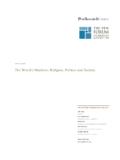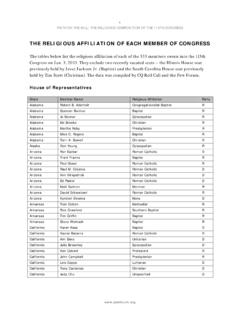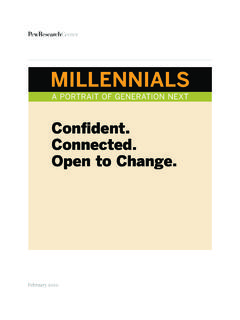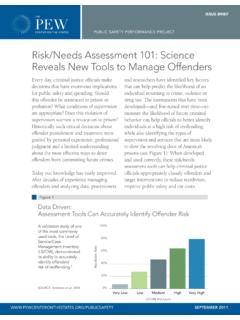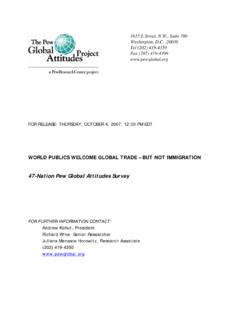Transcription of RELIGION IN THE PUBLIC SCHOOLS - Pew …
1 RELIGION IN THE PUBLIC SCHOOLSMAY 2007 Nearly a half-century afterthe Supreme Court issued its land-mark ruling striking down school -sponsored prayer, Americans continue tofight over the place of RELIGION in PUBLIC SCHOOLS . Indeed, the classroom hasbecome one of the most important battlegrounds in the broader conflict overreligion s role in PUBLIC Americans are troubled by what they see as an effort on the part of fed-eral courts and civil liberties advocates to exclude God and religious sentimentfrom PUBLIC SCHOOLS . Such an effort, these Americans believe, infringes uponthe First Amendment right to the free exercise of libertarians and others, meanwhile, voice concern that conservativeChristians are trying to impose their values on students of all religious courts, the civil libertarians point out, have consistently interpreted theFirst Amendment s prohibition on the establishment of RELIGION to forbid statesponsorship of prayer and most other religious activities in PUBLIC that long series of court decisions, polls show that large numbers ofAmericans favorlooser, not tighter.
2 Limits on RELIGION in PUBLIC to an August 2006 survey by the Pew Research Center, more thantwo-thirds of Americans (69%) agree with the notion that liberals have gonetoo far in trying to keep RELIGION out of the SCHOOLS and the government. Anda clear majority (58%) favor teaching biblical creationism along with evolutionin PUBLIC over RELIGION in school are hardly new. In the 19th century,Protestants and Catholics frequently fought over Bible reading and prayer inpublic disputes then were over whichBible and whichprayers wereappropriate to use in the classroom. Some Catholics were troubled that theschools reading materials included the King James version of the Bible, whichRELIGION AND THE COURTS: THE PILLARS OF CHURCH-STATE LAW was favored by Protestants.
3 In 1844, fighting brokeout between Protestants and Catholics inPhiladelphia; a number of people died in the vio-lence and several Catholic churches were conflicts erupted during the 1850s inBoston and other parts of New England. In theearly 20th century, liberal Protestants and theirsecular allies battled religious conservatives overwhether students in biology classes should betaught Charles Darwin s theory of Supreme Court stepped into those controver-sies when it determined, in Cantwell v. Connecticut(1940) and Everson v. Board of Education of EwingTownship(1947), that the First Amendment s FreeExercise Clause and Establishment Clause appliedto the two clauses say, Congress shallmake no law respecting an establishment of reli-gion, or prohibiting the free exercise thereof.
4 Before those two court decisions, courts hadapplied the RELIGION clauses only to actions of thefederal after the Eversondecision, the SupremeCourt began specifically applying the religionclauses to activities in PUBLIC SCHOOLS . In its firstsuch case,McCollum v. Board of Education(1948),the high court invalidated the practice of havingreligious instructors from different denominationsenter PUBLIC SCHOOLS to offer religious lessons dur-ing the school day to students whose parentsrequested them. A key factor in the court s decisionwas that the lessons took place in the SCHOOLS . Fouryears later, in Zorach v. Clauson, the court upheldan arrangement by which PUBLIC SCHOOLS excusedstudents during the school day so they couldattend religious classes away from school in the 1960s, the court handed religiousconservatives a series of major defeats.
5 It beganwith the landmark 1962 ruling,in Engel ,that school -sponsored prayer, even if it were non-sectarian,violated the Establishment Clause. Sincethen, the Supreme Court has pushed forward, frombanning organized Bible reading for religious andmoral instruction in 1963 to prohibiting prayers athigh school football games in these and other decisions, the court has repeat-edly stressed that the Constitution prohibits publicschools from indoctrinating children in it is not always easy to determine exactlywhat constitutes indoctrination or school sponsor-ship of religious activities. For example, can a classon the Bible as literature be taught without a biasfor or against the idea that the Bible is religioustruth?
6 Can students be compelled to participate ina Christmas-themed music program? Sometimesstudents themselves, rather than teachers, adminis-page 2 RELIGION in the PUBLIC SchoolsTABLE OF CONTENTSP rayer and the Pledge ..3 school Prayer ..3 The Pledge of Allegiance ..4 school Officials and Student Speech ..6 RELIGION in the Curriculum ..7 Creationism and Evolution ..7 Study of the Programs ..9 Multiculturalism ..9 Rights in and out of the Classroom ..9 Rights of of Parents ..11 Rights of Teachers and Administrators ..13 Religious Activities and the Principle of Equal Access ..14trators or coaches, bring their faith into schoolactivities. For instance, when a student invokesgratitude to God in a valedictory address, or ahigh school football player offers a prayer in ahuddle, is the school legally responsible for theirreligious expression?
7 The issues are complicated by other constitutionalguarantees. For instance, the First Amendment alsoprotects freedom of speech and freedom of associ-ation. Religious groups have cited those guaran-tees in support of student religious speech and inefforts to obtain school sponsorship and resourcesfor student religious right of a student or student club to engagein religious speech or activities on school propertymay, however, conflict with other protections, suchas the right of students to avoid recent case, for example, a federal appealscourt approved a high school s decision to prohibita student from wearing a T-shirt containing a bib-lical passage condemning student had graduated by the time theSupreme Court granted his appeal.
8 The SupremeCourt ordered the lower court to vacate its rulingand dismiss the another instance of conflicting rights, some stu-dent religious groups want the right to excludestudents who do not share the groups beliefs,specifically on questions of sexuality. For example,the Christian Legal Society, which has chapters inmany law SCHOOLS , is embroiled in litigation overits policy that only students who believe that sexoutside of heterosexual marriage is a sin can servein leadership these more recent conflicts show, PUBLIC schoolsremain a battlefield where the religious interests ofparents, students, administrators and teachers conflicts affect classroom curricula, highschool football games,student clubs.
9 Graduationceremonies and the lives of everyone with aninterest in PUBLIC and the PledgeSchool PrayerThe most enduring and controversial issue relatedto school -sponsored religious activities is class-room prayer. In Engel (1962), the SupremeCourt held that the Establishment Clause prohib-ited the recitation of a school -sponsored prayer inpublic a simple and seem-ingly nonsectarian prayer composed especially foruse in New York s PUBLIC SCHOOLS . In banning theprayer exercise entirely, the court did not rest itsopinion on the grounds that unwilling studentswere coerced to pray; that would come muchlater. Rather, the court emphasized what it saw asthe wrongs of having the government create andsponsor a religious following year, the high court extended theprinciple outlined in Engelto a program of dailypage 3 RELIGION in the PUBLIC SCHOOLS [T]he court has repeatedly stressedthat the Constitution prohibits publicschools from indoctrinating children in RELIGION .
10 But it is not always easyto determine exactly what constitutesindoctrination or school sponsorship of religious reading. In Abington school District v. Schempp,the court ruled broadly that school sponsorship ofreligious exercises violates the the source of the enduring con-stitutional doctrine that all government actionmust have a predominantly secular purpose arequirement that, according to the court, theBible-reading exercise clearly could not satisfy. Byinsisting that religious expression be excluded fromthe formal curriculum, the Supreme Court wasassuring parents that PUBLIC SCHOOLS would be offi-cially secular and would not compete with parentsin their children s religious Engeland Schempp, the court outlined theconstitutional standard for prohibiting school -sponsored religious expression,a doctrine thecourt has firmly maintained.
